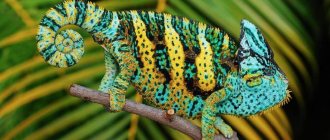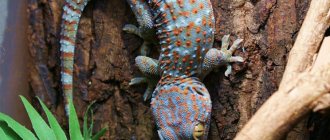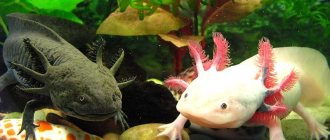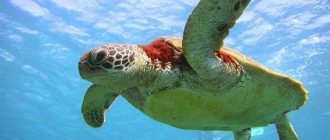The common tree frog (evichaina) is a miniature frog, the body size of which is only 5 centimeters. It belongs to the order of tailless frogs of the family. A distinctive feature of the animal is the rapid change of color, which can change before our eyes and depends on various factors. Normally, the skin color is green, but it can change and become white, gray, or brownish-brown.
Tree frogs are able to change color depending on external conditions
Frog family, species for terrarium
There are several types of them that get along well in a terrarium. Conditions for caring for them depend on the variety. Let's look at some of them.
The terrarium can contain such animals as: giant Achatina, tarantula spider, crocodile, black widow, iguana, tarantula, chameleon, salamander, monitor lizard, marsh turtle, ciliated bananaeater, sand boa, Madagascar cockroach, leopard gecko, corn snake, scolopendra and gecko .
Bright-eyed tree frogs (Agalychnis)
There are 8 species of tree frogs in the genus Bright-eyed tree frog, and the red-eyed tree frog is one of them. It reaches a length of 7.5 cm. Living in nature, it prefers to live in the middle or upper tiers of trees. The main color of green allows it to camouflage perfectly among the leaves. The bases of the frog's legs and sides are blue with a yellow pattern, and the toes are orange.
A distinctive feature of this species is its red eyes. This species eats various natural inhabitants, such as insects, small lizards, arachnids, etc. Their breeding season can last throughout the year - this is due to their tropical habitat.
Important! Do not place sharp objects or heating elements in the cage as this could cause injury to the frog. If this happens, it is necessary to treat the wound with a solution of dioxidine and streptocide.
To keep a tree frog at home, you can choose a small terrarium and plant it with vines and other non-thorny plants. Humidity conditions should be maintained, implying values above 75%, and a temperature of 30°C. For lighting conditions, it is better to choose fluorescent lamps. You can feed the frog flies, crickets and other insects. In addition, you can offer the animal a small mouse or reptile.
Tree Frogs (Hyla): Blue Tree Frog (Hyla cinerea)
The blue tree frog reaches a length of 4-5 cm. Living in nature, it prefers to live on the shore of a reservoir, as well as in bushes and near coastal thickets of grass. The main color is grassy green. The back and belly of the animal are separated by a bright white stripe, starting from the middle of the frog's muzzle. In males, the throat sac is especially developed, and at the tips of the paws there are round-shaped suckers; the hind paws have small membranes. This species, like others, prefers to eat insects, as well as lizards and arachnids.
Did you know? Goliath is considered the largest frog in the world; its weight reaches 3 kg and its height is 90 cm.
A vertical terrarium is suitable for keeping blue tree frogs at home. You can arrange it with the help of living plants and a relief background made of plastic or tree bark. It is necessary to set the air temperature in it to 20-25°C and create conditions of high humidity, as well as organize a spacious drinking bowl. For this type of frog, group keeping is acceptable.
Australian tree frogs (Litoria)
The Australian tree frog is one of the largest tree frogs. It reaches 15 cm in length, but males can be 7 cm smaller. Although males are smaller in size than females, they have pronounced muscles, and on the forelimbs there is a so-called “nuptial callus”, which has a dark color. This amphibian is accustomed to living in both dry and humid environments, but it prefers lowland forests. Its extravagant color is capable of changing colors, adapting to the background of the environment. So, in the daytime, the Australian tree frog can change color to black.
The appearance has distinctive features in the form of small white or golden spots, the throat and belly are pink or white. The base color varies from bright to dark shades of green. In addition, both turquoise and brown colors are found. Let us describe in more detail the elements of color and physiology of the amphibian. The inner side of its thigh is painted in purple shades, and on the shoulder and sides there are white spots with a dark border. Typically, the voice of this frog can be heard from April to September. And you can notice that the female’s voice sounds more shrill than the male’s.
Exoticism has become popular, so pet lovers often get animals such as: jumper, kea parrot, mini-pig, raccoon, newt, lemur, capybara, jungle cat, manul, monkey, possum, nose, jaguarundi, fennec fox, Tasmanian devil, mongoose , sand cat and Temminka cat.
The tree frog's skin can be covered with a special waxy coating that prevents drying out during hot weather. Moisture reserves accumulate in free-hanging folds. The functional features of dermatology do not end there. Thus, during periods of high humidity, the skin releases antibacterial substances with antiviral effects. This helps treat hypertension.
Did you know? Research by scientists shows that the Australian tree frog is able to regulate the amount of water that evaporates through its skin. This allows her to control body temperature.
Note that Litoria reproduces in the summer months during the rainy season. During this period, the male's nuptial callus increases in size in order to be able to capture the female during intercourse. The process of laying eggs takes several days. One clutch, as a rule, contains 150-300 eggs. The eggs reach sizes of 1.1-1.4 mm.
This species adapts perfectly to keeping at home, as it has a tame nature. Frogs are not afraid of people and are active around the clock, which can be regulated using lighting. The amphibian feeds on moths, locusts, cockroaches and other insects. The frog can live 14-16 years. However, there is a case in California where a frog lived to be 21 years old.
Keeping a tree frog will not cause much trouble. Optimal conditions would be a terrarium with a volume of up to 200 liters with tree branches and other landscaping located in it, as well as ventilation and lighting. It is necessary to maintain the temperature in the range of +22-26°C, and at night it is better to adhere to a reduced regime.
Check out the top 10 best aquarium plants.
It is necessary to spray the terrarium every day and moisten its bottom to recreate the humidity that is characteristic of the frog’s natural habitat. It is better to use expanded clay or coarse gravel as a floor covering. Wooden structures in the form of driftwood, which can be placed both vertically and horizontally, will also not be out of place.
West Indian (Caribbean) tree frogs (Osteopilus)
There are 8 species of tree frogs belonging to the Caribbean tree frog genus. They are kept in vertical terrariums, which can be decorated at your discretion using driftwood, vines and other plants. Hygroscopic soil, coconut chips, sphagnum or ordinary soil are placed at the bottom. A layer of crushed bark will help keep the frog clean.
A spacious pond in the center of the terrarium will be just the thing for an amphibian. The optimal temperature is +22-24°C at night and up to +28°C during the day. The diet of the West Indian tree frog should include insects, including crickets, mealworms, wax moth larvae and others.
Toad frogs (Phrynohyas)
This species lives in the rain forests of the Amazon, Brazil, and off the coast of the Andes and is distinguished by an unusual ash-blue skin tone. Brown stripes located on top of the main color make it easy to camouflage in lichen, on the trunks of plants and trees, in grass and mud. Amphibians have a textured, pearl-colored coating. Their fingers are located freely and do not have membranes. The eyes are large, widely spaced and raised above the muzzle. The amphibian has a turquoise mucous membrane.
It lives in trees and feeds on Turkmen marbled cockroaches, but at home you can limit yourself to cockroaches or other insects from a pet store. For adults, room temperature and keeping them in a terrarium, the bottom of which is 5 cm filled with water, is quite suitable. These toads are otherwise called “harlequins” and “prisoners.”
A frightened individual of this species is capable of leaving sticky mucus, characterized by a pungent chemical odor - when it comes into contact with a person’s mucous membrane, it causes a burning sensation. In this regard, it is advisable to follow the safety rules for contact with it and be sure to wash your hands afterward. You can use regular gloves.
Phyllomedusa
Being one of the largest individuals representing the genus of tree frogs, it reaches the following sizes: the length of the male is 9-10 cm, the length of the female is 11-12 cm. It lives in the Amazon, in the north of Bolivia and in Brazil, in the east of Peru, in the southeast Colombia, Guyana. When choosing a habitat, this species prefers savannah and forests.
Important! Phyllomedusa venom can cause hallucinations and gastrointestinal upset.
If this species is kept in a home terrarium, its color becomes bright after 2 months. Reaches sexual maturity at the age of 6-10 months.
Description
The common tree frog is bright green, olive green, grey, yellow or brown in color and smooth. The underparts are white/cream in color and have a grainy texture. From the nostrils down along the body to the thigh there is a dark stripe on each side.
The hind legs of the common tree frog are much larger than the front and stronger, which allows the frogs to jump quickly. Each toe has adhesive discs that allow it to climb on surfaces. Tree frogs have horizontal eye pupils and have a very characteristic croaking sound. In Greek, Hyla means "barking".
Tree frog lifestyle
Tree frogs are nocturnal animals. Thus, during the daytime and during dry periods, they sit on the undersides of leaves or sleep on the tops of trees. Due to the fact that their eyelids have a base color, they are able to camouflage themselves while sleeping. At night, bright red eyes are better able to see prey, so the amphibian begins its hunt at this time of day. Physically developed muscles allow him to make very long jumps and catch prey in a timely manner.
Despite the fact that the tree frog is a fairly active animal, swims beautifully and is distinguished by extraordinary acrobatic abilities, it spends most of its time in a stationary state. This is due to the camouflage functions, because only by limiting your movements and having a suitable covering can you blend in with the environment. Some tree frogs, living in cool areas, can go underground, creating a home for themselves in a hollow, under a stone, in a hole or at the bottom of a reservoir. However, during the active season they get out.
Behavior
Woodworms spend most of their time on land. They spend the day in a secluded place and feed on insects flying past them. At dusk, the tree frog goes on a real hunt. She spends the night among tree branches or in thick grass, lying in wait for her prey. Having chosen a victim, it slowly approaches it, and then a lightning-fast jerk follows - and the prey ends up on its sticky tongue.
The small teeth of the upper jaw are able to provide a secure grip. Having swallowed the tasty morsel, the frog continues to hunt. To grab prey, it makes a long jump with its mouth wide open.
During the day, the tree tree rests, sitting on a leaf or choosing a comfortable place on a reed stem. It completely blends into the surrounding background. Its color is not constant and depends on light and humidity, as well as on the temperature and color scheme of the environment.
Coloring may reflect the emotional state of the amphibian. The common tree frog can acquire grassy green, lemon yellow, gray, brown and even lilac colors.
With the arrival of autumn cold, during leaf fall, the tree descends to the ground. She begins to search for winter shelter and, burrowing into leaf litter or warm moss, falls asleep. In April, the males wake up first, and only after 8 days do the females emerge from hibernation.
Keeping a tree frog in a terrarium
There are several ways to keep frogs. A terrarium is the best option for this in apartment living conditions. You can choose a horizontal or vertical type, based on the type of amphibian that will live there. It should be placed near a wall to avoid direct sunlight.
Did you know? Sometimes the tree frog molts, shedding its skin and instantly eating it.
The terrarium must be equipped with a lid with ventilation. In addition, it must have fluorescent lamps.
To increase the temperature, you can use a special mat, which is mounted from the outside to the bottom of the container. At the same time, you should not occupy its entire area with a heating element in order to give your pet the opportunity to avoid overheating. Placing such a device inside a vessel is extremely dangerous!
Terrarium and decorations
Every owner of such an unusual pet would like to make his home as comfortable and beautiful as possible. To begin with, soil is poured onto the bottom of the container and a pond is organized. A wooden driftwood found on the street is suitable as a vertical decoration, and if the size of the terrarium allows, you can place a stump with a hollow in it.
In addition, we should not forget about the direct landscaping of the habitat. For this, vines, grass, ferns and other plants are used. Such accessories can be purchased at a pet store or ordered online. Don't forget to regularly clean the glass and the inside of your pet's home. This will help prevent the occurrence of diseases and improve living conditions.
Temperature
The tree frog loves warmth and moisture, so to keep it, it is necessary to maintain a temperature of 20 to 30 ° C, depending on the species and time of day. You should not allow the amphibian to become hypothermic or overheated: this can have a detrimental effect on its skin and vital processes.
Priming
For some decorative elements of the terrarium, such as the floor, you can use ordinary soil, sand or gravel. A special substrate can also be purchased at the store. Since the common tree frog prefers to sit on dry land, it needs to be hydrated regularly.
Features of feeding
Red-eyed tree frogs prefer insects in their diet, so at home they are quite suitable:
- grasshoppers,
- crickets,
- cockroaches,
- and other food animals.
Sometimes frogs prefer worms, but in most cases they prefer grasshoppers. You can purchase special food intended for frogs living in a terrarium, which looks like canned grasshoppers, previously dried in a special way. However, if possible, feeding can also be done with live food.
All foods included in the frog's diet must be sprinkled with vitamin D3, as well as calcium. Such additives are of greatest importance for young individuals during their growing up period. They must use this supplement during each feeding, but adult tree frogs can take it much less frequently.
A multivitamin should also be administered, which reptiles need one to two times a week. You should always carefully study the instructions for vitamins and supplements to avoid overdose.
Shared housing with other inhabitants
The main problem with housing together is that the inhabitants can eat each other. To avoid this, it is necessary to have species of the same size. In addition, the conditions of detention they require must be the same.
Poisonous representatives should not be housed in the same housing as other species. Snakes would also be inappropriate, since caring for them is fundamentally different from caring for toads. But lizards, for example, get along well with frogs.
Substrate
Substrate is the bedding or lining for the bottom of your pet's cage. The safest, easiest, and most cost-effective option is a reptile rug or coconut fiber rug. They are easy to clean and safer as your frog cannot swallow them by mistake.
However, you can still use other substrates such as cypress mulch or organic soil, moss, cork bark or smooth gravel. You can try to clean the pea gravel every week, but it will require boiling to properly disinfect it, so it's best to replace it entirely every week.
If your frog eats some of its substrate along with insect meal, consider switching to reptile carpet or coir mat, which may prevent future health problems.
Breeding
To create the necessary conditions for reproduction, it is necessary to organize a pond with standing water, shrubs and tall plants. The males climb on them and begin to sing mating songs. The female, as a rule, lays from 3 to 21 portions of eggs. From the age of 8 months, the frog is capable of reproduction and lays its eggs in the tops of tree stumps or in hollows. The future offspring are covered with a special shell. During the process, amphibians croak loudly.
After 12-15 hours, the beginning of embryo development can be observed. A few days after this, they transform into tadpoles and begin active movement. In this case, it is necessary to observe the density of their content. So, for 1 tadpole there should be 3-5 liters of water. Its temperature should be 24-26°C. You can feed tadpoles with cod liver, scalded nettle, as well as special food for aquarium fish. With plenty of food, they will grow quickly and already at the age of 1 month will reach 3-4 cm.
Important ! It is recommended to add dense peat plates as fillers to the air purification filter in the terrarium. This will increase the acidity of the water and reduce the mortality of offspring.
Reproduction
When the breeding season begins, frogs choose a suitable place for themselves. Usually this is a small standing body of water, which is surrounded by dense and tall vegetation (shrubs or reeds). Males are in the water and call females with rhythmic calls. It was the males that nature awarded with throat resonators , which they actively use during the mating season and thanks to which the “melody” characteristic of frogs is heard. At the reservoir, which will serve as a spawning ground, male frogs from all over the area gather and their choral singing reaches its climax in the evening.
Females begin to gather at the breeding site only to lay eggs, while males remain at the spawning site throughout the spawning period. In view of this, there are always a larger number of them in the reservoir, and females have a choice.
The female lays eggs in several portions (from three to twenty-one). They are a small ball of eggs that attaches to aquatic plants. One serving can contain from 15 to 215 eggs. The development of embryos lasts about two weeks, after which they become larvae, and their growth continues for another 1.5 to three months.
Sometimes the larvae in small frogs grow only after winter, and overwinter as larvae. Tree frogs reach sexual maturity at two to four years of age. Life expectancy in the natural environment is about 12 years, and when kept in terrariums it grows to 20-22 years.
General health problems
As with most amphibians, bacterial and fungal infections of the skin and eyes are common. Pus (which may appear dull), swelling, or redness are signs of illness.
Although less common in frogs than other reptiles and amphibians, respiratory infections can occur in frogs that have enclosures with insufficient or too high humidity.
Symptoms of a respiratory infection include wheezing, drooling and general lethargy.
If your frog is not eating well and is not showing other obvious symptoms, it may have a parasitic infection. This usually needs to be diagnosed by an exotics veterinarian who specializes in reptiles and amphibians.
Your veterinarian should take a stool sample annually to make sure your frog is not experiencing an overgrowth of common parasites.
In addition, pet frogs are susceptible to ammonia poisoning, a potentially fatal disease that occurs when waste accumulates in the animal's enclosure.
Ammonia buildup can be prevented by regular weekly cleaning.
All of these ailments can be treated by a qualified veterinarian if they are detected early.
Population/conservation status
Currently, the population size of the species is gradually declining. Threats to the species: loss and degradation of habitat (water pollution, deforestation, construction of hydraulic structures). Currently, there are 6-8 subspecies, of which 3 are found within our country. A poison is secreted on the skin - a peptide that is not dangerous to humans. After contact with a frog, it is advisable to wash your hands.
The common tree frog is listed in the IUCN Red List as a species with a low risk of extinction.
Literature: 1. I.P. Sosnovsky. Amphibians and reptiles of the forest, Timber industry, 1983 2. Key to amphibians and reptiles of the fauna of the USSR. Moscow, “Enlightenment”, 1977 3. Altmann Khorog. Poisonous plants. Poisonous animals/Translated by him. - M.: 4. Ya. I. Garanin, Amphibians and reptiles of the Volga-Kama region, Publishing House "Nauka", 1983 5. Translation from English www.zooclub.ru 6. Amphibians of Ukraine. Evgeny Pisanets, Kyiv, 2007 7. Essays on biology. A.G. Bannikov, M.N. Denisova. Moscow, 1956 8. Plants and animals. K. Nidon, Dr. I. Peterman, P. Scheffel, B. Shayba Translation from German by N.V. Khmelevskaya, Moscow “Mir”, 1991











